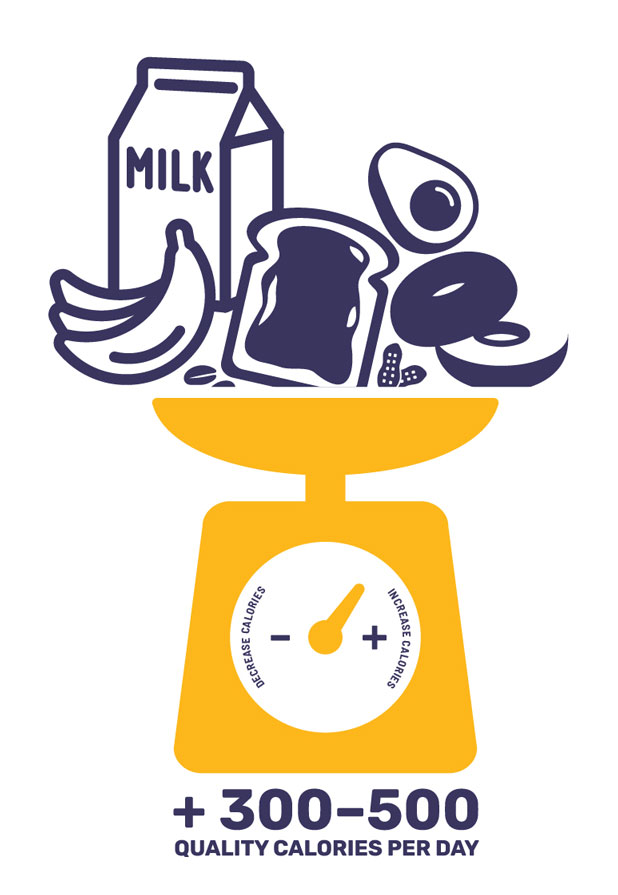If you’re trying to gain muscle to bulk up, the key is to increase your calorie intake along with a proper exercise regimen. For many, this can be challenging when busy and active lifestyles make it hard to eat enough. It might be tempting to reach for any source of extra calories or resort to supplements in an effort to add muscle, but these aren’t always the healthiest or most effective strategies. Still, there are things you can do to achieve healthy weight gain for better military fitness.
To gain weight, aim for an additional 300–500 calories each day. You can meet this target by choosing the right foods and drinks to meet your nutrient needs and support optimal performance. The following tips can help you develop your own fueling plan to support your weight-gain goals.
Eat often
Try to eat every 2–4 hours throughout the day. Aim for 3 balanced meals and 2–4 healthy snacks daily. This is one of the most effective strategies for increasing calories, as well as protein and other nutrients, to support weight gain. For example, if you eat 1–2 extra snacks in addition to your usual intake throughout the day, this can easily help you meet your need for additional calories.
Choose calorie- and nutrient-rich foods
There are many nutrient-dense foods to choose from to help boost your calorie intake.
- Vegetables. Pick potatoes, beans, peas, lentils, winter squash (acorn or butternut), or corn.
- Fruits. Try bananas, papaya, cherries, mango, dried fruit (dates or raisins), or applesauce.
- Grains. Enjoy whole-grain pasta, quinoa, brown or wild rice, granola, or whole-grain bagels, hoagies, or thick slices of bread.
- Protein. Choose cold-water fish (salmon, tuna, or sardines), milk, Greek yogurt, cheese, lean meats or poultry, tofu, or tempeh.
- Healthy fats. Consume nuts or nut butter, seeds, avocados, or oil (olive, avocado, or grapeseed).
 Be consistent
Be consistent
For successful weight gain, prioritize eating often every day. For example, you might find it easier to eat during the week when your schedule is more consistent. But if you sleep in late on weekends and miss breakfast and a morning snack, you might lose opportunities to eat. Even when your usual routine is off, try to stay on a regular fueling schedule. Consistency is key! Eat every few hours each day to meet your nutrient needs to support weight gain.
To gain weight, aim for an additional 300–500 calories each day.
Be strategic with protein
Protein is important if you’re trying to build muscle, but once you’ve met your needs, extra protein is either burned for energy or stored as fat. Too much protein can fill you up and displace other important nutrients such as carbohydrates. So, spread protein-rich foods throughout the day to maximize your body’s ability to build muscle. Everyone’s needs are a little different, but aim for roughly 20 grams of protein every few hours. If you’re exercising particularly hard, consider adding a protein-rich bedtime snack to support muscle growth and repair overnight.
Include resistance training
Exercise matters. Without it, you can’t expect to gain muscle just by eating more calories and protein. It’s also important to resistance train for muscle hypertrophy, which is the process of increasing muscle by increasing the size of your muscle fibers. To maximize muscle growth, follow proper nutrient-timing strategies to fuel and recover from exercise, including having a carbohydrate and protein-rich snack within 30 minutes of your workout.
Consistency is key! Eat every few hours each day to meet your nutrient needs to support weight gain.
Add extras
An easy way to add calories is to add nutrient-rich extras to your meals and snacks. Try topping your salads with nuts, sliced avocado, or beans. Another idea is to spread nut butter on foods like apples or crackers. These additions might not seem like much, but they add up over the course of the day.
Try liquid calories
Beverages don’t tend to be as filling as solid foods, and they can be a great way to add in extra calories without feeling too full. Milk and milk alternatives, smoothies, and 100% fruit juice are smart options. Just watch out for drinks with added sugar.
Choose food over dietary supplements
Weight-gain or bodybuilding supplements might sound tempting, but when you make the right food choices, you can easily meet your additional calorie and protein needs to gain weight. If you’re considering a supplement, visit Operation Supplement Safety to learn more about safe supplement use.
Be realistic
You can certainly alter your weight through food and exercise, but keep in mind that your genes play a large part in your build. If you’re naturally small, don’t expect to put on and maintain 30 pounds of muscle. Plus, some people put on muscle easier than others. It’s important to be realistic in your weight-gain goals and be patient during the process. It can take months to see results. If you need further guidance on how to build muscle, visit a Registered Dietitian (RD) who can help you develop your own individualized fueling plan.
